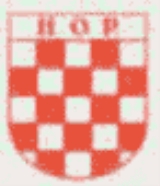
Croatian Liberation Movement
Encyclopedia
The Croatian Liberation Movement is a right-wing party originally formed by Croatia
n emigrants and headed by former leaders of the Axis allied Independent State of Croatia
(NDH) in 1956.
It was headed by Ante Pavelić
, former leader of the NDH . Other signatories of HOP's first declaration were Džaferbeg Kulenović
, Vjekoslav Vrančić
, Ivica Frković, Ivan Kordić, Stjepan Hefer, Stipe Matijević and Josip Marković. All escaped Europe and certain death for war crimes in Yugoslavia.
The organization was created to represent right-wing Croatian interests which had been crushed by the nation's union in Yugoslavia
. The HOP considered itself a democratic organization which was against communism
.
, Argentina
. However, it had branches in many countries around the world. Some consider HOP as a continuation of the Ustaša movement of the Second World War
. However, apart from the former Ustaša members who were now in HOP, the two organizations did not share much in common except their leadership and nationalism. They both believed in an independent Croatia, but unlike the Ustaša movement, HOP was not a militant organization. It served to represent Croatian interests as well as it could and united parts of the Croatian diaspora
which had been fragmented from one another.
Today, HOP functions as a small political party within Croatia which has no seats in the Croatian Parliament but has active branches in Toronto, Winnipeg, and Vancouver, Canada, Melbourne, Australia and in Sydney, Australia. Melbourne and Winnipeg also have a Youth branch of HOP known as 'Mladež' which are still active in organising social activities and raising political awareness amongst their respective Croatian communities in the diaspora.
Croatia
Croatia , officially the Republic of Croatia , is a unitary democratic parliamentary republic in Europe at the crossroads of the Mitteleuropa, the Balkans, and the Mediterranean. Its capital and largest city is Zagreb. The country is divided into 20 counties and the city of Zagreb. Croatia covers ...
n emigrants and headed by former leaders of the Axis allied Independent State of Croatia
Independent State of Croatia
The Independent State of Croatia was a World War II puppet state of Nazi Germany, established on a part of Axis-occupied Yugoslavia. The NDH was founded on 10 April 1941, after the invasion of Yugoslavia by the Axis powers. All of Bosnia and Herzegovina was annexed to NDH, together with some parts...
(NDH) in 1956.
It was headed by Ante Pavelić
Ante Pavelic
Ante Pavelić was a Croatian fascist leader, revolutionary, and politician. He ruled as Poglavnik or head, of the Independent State of Croatia , a World War II puppet state of Nazi Germany in Axis-occupied Yugoslavia...
, former leader of the NDH . Other signatories of HOP's first declaration were Džaferbeg Kulenović
Džaferbeg Kulenovic
Dr. Džafer-beg Kulenović was the Vice President of the Independent State of Croatia between 1941 and 1945, being one of the highest ranking Muslims in the NDH...
, Vjekoslav Vrančić
Vjekoslav Vrancic
Vjekoslav Vrančić was a member of the Croatian World War II Ustaše regime. As the undersecretary for the interior, he was responsible for the concentration camps set up in Croatia and the repressive acts of the police....
, Ivica Frković, Ivan Kordić, Stjepan Hefer, Stipe Matijević and Josip Marković. All escaped Europe and certain death for war crimes in Yugoslavia.
The organization was created to represent right-wing Croatian interests which had been crushed by the nation's union in Yugoslavia
Yugoslavia
Yugoslavia refers to three political entities that existed successively on the western part of the Balkans during most of the 20th century....
. The HOP considered itself a democratic organization which was against communism
Communism
Communism is a social, political and economic ideology that aims at the establishment of a classless, moneyless, revolutionary and stateless socialist society structured upon common ownership of the means of production...
.
Argentina
HOP was based in Buenos AiresBuenos Aires
Buenos Aires is the capital and largest city of Argentina, and the second-largest metropolitan area in South America, after São Paulo. It is located on the western shore of the estuary of the Río de la Plata, on the southeastern coast of the South American continent...
, Argentina
Argentina
Argentina , officially the Argentine Republic , is the second largest country in South America by land area, after Brazil. It is constituted as a federation of 23 provinces and an autonomous city, Buenos Aires...
. However, it had branches in many countries around the world. Some consider HOP as a continuation of the Ustaša movement of the Second World War
World War II
World War II, or the Second World War , was a global conflict lasting from 1939 to 1945, involving most of the world's nations—including all of the great powers—eventually forming two opposing military alliances: the Allies and the Axis...
. However, apart from the former Ustaša members who were now in HOP, the two organizations did not share much in common except their leadership and nationalism. They both believed in an independent Croatia, but unlike the Ustaša movement, HOP was not a militant organization. It served to represent Croatian interests as well as it could and united parts of the Croatian diaspora
Diaspora
A diaspora is "the movement, migration, or scattering of people away from an established or ancestral homeland" or "people dispersed by whatever cause to more than one location", or "people settled far from their ancestral homelands".The word has come to refer to historical mass-dispersions of...
which had been fragmented from one another.
Today, HOP functions as a small political party within Croatia which has no seats in the Croatian Parliament but has active branches in Toronto, Winnipeg, and Vancouver, Canada, Melbourne, Australia and in Sydney, Australia. Melbourne and Winnipeg also have a Youth branch of HOP known as 'Mladež' which are still active in organising social activities and raising political awareness amongst their respective Croatian communities in the diaspora.

